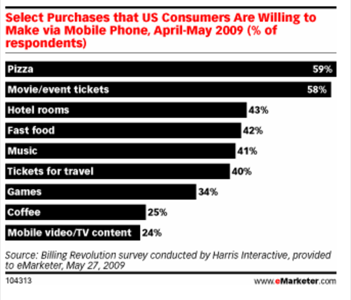There’s no question that mobile web use is on the rise. Recent reports tell us that cellular networks worldwide are seeing major increases in growth. In fact, there are even concerns that the current infrastructure won’t be able to keep up with the new demands. According to one research firm, 3G traffic in developed markets will increase by 20% by the end of 2014 but some operators will face HSPA capacity shortfalls as soon as mid-2010, if not earlier. Forrester Research also recently predicted that more than a third of Europeans will be accessing the mobile internet by 2014.

With these levels of growth, we’re also seeing related mobile services getting a boost. App stores, both phone-based and carrier-based, are popping up left and right, mobile video usage is booming, and mobile ad markets are seeing dramatic growth, too. However, there’s one area that hasn’t yet benefitted from the mobile revolution: mobile e-commerce.
This is part 1 of a two-part article on the mobile e-commerce market in relation to other mobile trends. Part 2 is here.
The indicators of increased mobile web usage are everywhere. Just this week, we heard Facebook reporting their mobile growth had tripled from December of last year to this past month, for example. And then there’s AT&T, the carrier for Apple’s iPhone, which is seeing so much data usage that they couldn’t even keep up, having to delay the introduction of new iPhone capabilities like MMS messaging until they were ready to handle the demand.
Mobile Ads Doing Well
Mobile-dependent markets are doing well, too, at least for the most part. A recent Gartner report states that mobile ad spending will grow 74% this year worldwide to $914.5 million. But the real growth won’t happen until 2011 when advertisers are expected to fully embrace the shift to mobile. By 2013, the firm expects the mobile ad market to surpass $13 billion with the Asia-Pacific region in the lead, followed by North America and Europe. Not only is the rise of the smartphone to thank for this trend, so is the rise in flat-rate data plans which make it easier for more consumers to afford mobile web connectivity. As more consumers go online, more web publishers begin to cater to their needs with mobile-ready versions of their websites. This, in turn, “is lifting mobile web access among non-smartphone users,” notes Gartner analyst Andrew Frank.
Mobile Video on the Rise
Along with basic web surfing, mobile users are also finding entertainment via their handhelds, specifically in the form of mobile video. According to Nielsen’s latest three-screen report, the number of people watching mobile video increased 70% from last year. Nielsen, which specifically tracks American media habits, says this increase to 15 million viewers represents the largest annual growth to date.
M-Commerce Struggles
However, not all mobile-dependent markets are doing well. Mobile e-commerce, for example, is struggling. Despite the massive numbers of mobile users, those using their phones to make purchases are still few and far between…at least here in the U.S. According to new data from eMarketer, more than 70 million U.S. mobile phone users will access the internet from their devices this year, but the m-commerce market remains immature. In an April 2009 survey by RIS News, privacy and security concerns are still at the forefront of both shoppers’ and retailers’ minds. This had led companies to drag their feet when it comes to introducing their mobile commerce plans. Says Jeffrey Grau, eMarketer senior analyst, “most retailers are either standing on the sidelines or in the midst of planning their mobile commerce strategy.”
Another major problem is the lack of standardization in the mobile space. With the number of platforms now available, retailers find building a plethora of mobile applications not worth the effort. As InfoWorld recently noted, the smartphone market has become a “tower of Babel for developers.” This means that mobile retailers have to carefully pick-and-choose the platforms they plan to support in order to see reasonable returns on their investments in this space. Despite the slow growth, it appears that m-commerce could be successful if only there were enough mobile apps and shopping opportunities out there.
Already, mobile payments firm Billing Revolution found that on-the-go consumers seem happy to purchase small ticket items like pizza and movie tickets, for example.

And a March 2009 PriceGrabber.com survey found that early m-commerce adopters were even buying up higher priced items like consumer electronics, apparel and jewelry.
In other words, when it comes to m-commerce, “if you build it, they will come.” , or so it seems. However, developing m-commerce applications is only one part of the equation. For mobile e-commerce to be successful, we’ll need to adopt a number of mobile payment platforms too.
To be continued in part 2…









